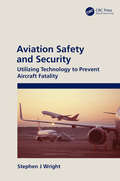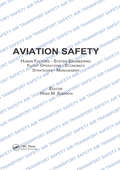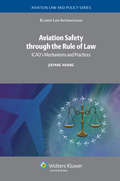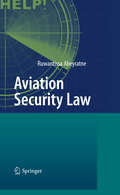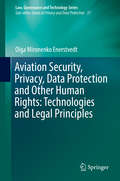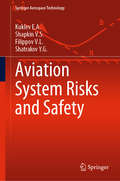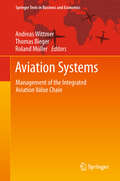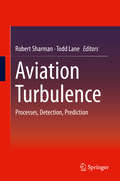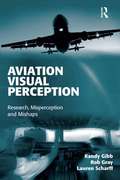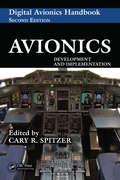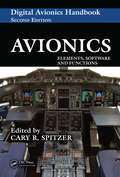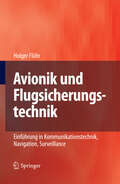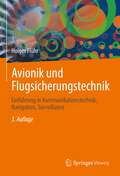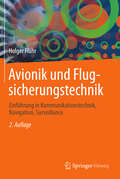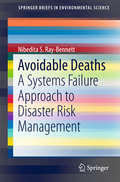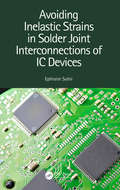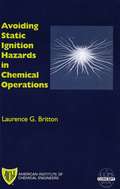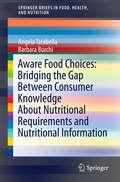- Table View
- List View
Aviation Safety and Security: Utilizing Technology to Prevent Aircraft Fatality
by Stephen J WrightThis book focuses on ways to better manage and prevent aircraft-based homicide events while in flight using alternate technology to replace the Cockpit Voice Recorder (CVR) and/or Digital Flight Data Recorder (DFDR) functions. While these events are infrequent, the implementation of real-time predictive maintenance allows aircraft operators to better manage both scheduled and unscheduled maintenance events. Aviation Safety and Security: Utilizing Technology to Prevent Aircraft Fatality explores historical events of in-flight homicide and includes relevant accident case study excerpts from the National Transportation Safety Board (NTSB) and Air Accidents Investigation Branch (AAIB). FEATURES Explores historical events of in-flight homicide and offers solutions for ways to mitigate risk Explains how alternate technologies can be implemented to address in-flight safety issues Demonstrates that metrics for change are not solely for safety but also for financial savings for aircraft operation Includes relevant accident case study excerpts from the NTSB and AAIB Expresses the need for real-time predictive maintenance Stephen J Wright is an academic Professor at the faculty of Engineering and Natural Sciences at Tampere University, Finland, specializing in aviation, aeronautical engineering, and aircraft systems.
Aviation Safety, Human Factors - System Engineering - Flight Operations - Economics - Strategies - Management
by Hans M. SoekkhaQuestions concerning safety in aviation attract a great deal of attention, due to the growth in this industry and the number of fatal accidents in recent years. The aerospace industry has always been deeply concerned with the permanent prevention of accidents and the conscientious safeguarding of all imaginable critical factors surrounding the organization of processes in aeronautical technology. However, the developments in aircraft technology and control systems require further improvements to meet future safety demands. This book embodies the proceedings of the 1997 International Aviation Safety Conference, and contains 60 talks by internationally recognized experts on various aspects of aviation safety. Subjects covered include: Human interfaces and man-machine interactions; Flight safety engineering and operational control systems; Aircraft development and integrated safety designs; Safety strategies relating to risk insurance and economics; Corporate aspects and safety management factors --- including airlines services and airport security environment.
Aviation Safety, Human Factors - System Engineering - Flight Operations - Economics - Strategies - Management
by Hans M. SoekkhaQuestions concerning safety in aviation attract a great deal of attention, due to the growth in this industry and the number of fatal accidents in recent years. The aerospace industry has always been deeply concerned with the permanent prevention of accidents and the conscientious safeguarding of all imaginable critical factors surrounding the organization of processes in aeronautical technology. However, the developments in aircraft technology and control systems require further improvements to meet future safety demands. This book embodies the proceedings of the 1997 International Aviation Safety Conference, and contains 60 talks by internationally recognized experts on various aspects of aviation safety. Subjects covered include: Human interfaces and man-machine interactions; Flight safety engineering and operational control systems; Aircraft development and integrated safety designs; Safety strategies relating to risk insurance and economics; Corporate aspects and safety management factors --- including airlines services and airport security environment.
Aviation Safety through the Rule of Law: ICAO's Mechanisms and Practices
by J. HuangFlight is inherently a risky venture, carried out in a hostile environment at great speed. Realistically and regrettably, a commitment to aviation safety can achieve no more than ‘as few accidents as possible’. Moreover, the tragic events of 11 September 2001 have conclusively demonstrated that aviation safety goes beyond accident prevention from a technical point of view and extends to more profound political, strategic and legal dimensions. Accordingly, aviation safety requires a multidisciplinary approach: technical, economic, managerial, and legal. This ground-breaking study analyzes, from a legal point of view, the mandate of the International Civil Aviation Organization (ICAO) relating to aviation safety in the light of changes which have taken place since the conclusion of the Chicago Convention, including the expansion of the international civil aviation community, the liberalization of the aviation industry, the introduction of new technology, and existing as well as new and emerging terrorist threats. The author clearly demonstrates that ICAO, as the worldwide governmental organization for international civil aviation, should be allowed a more proactive role in enhancing aviation safety. Describing in great detail the contributions of ICAO to the global safety regime and mechanisms, he submits effective ways to rationalize ICAO’s quasi-legislative and enforcement functions in order to enhance aviation safety through the rule of law. Among the important topics arising in the course of the analysis are the following: global ramifications of national and regional initiatives; auditing of state compliance with international standards; characterization of crimes against the safety of civil aviation; importance of ensuring that safety requirements are not compromised by profit considerations; burgeoning of airline alliances, code-sharing and outsourcing activities; demands for simplification and unification of certain regulatory procedures; prohibition of the use of weapons against civil aircraft in flight; development of new technology, such as satellite-based navigation systems; and importance of the rule of law and the system of checks and balances in international organizations. As a plea to consider civil aviation safety obligations not only as merely contractual obligations between States but as obligations owed to the international community as a whole, this book is sure to give rise to far-reaching discussions and follow-up among policymakers and the interested legal community in the years to come.
Aviation Security Law
by Ruwantissa AbeyratneThe law plays a significant role in ensuring aviation security. This book addresses new and emerging threats to civil aviation; evaluates security tools now in use such as the Public Key Directory, Advance Passenger Information, Passenger Name Record and Machine Readable travel documents in the context of their legal and regulatory background; and discusses applicable security treaties while providing an insight into the process of the security audits conducted by the International Civil Aviation Organization (ICAO). The book also examines issues of legal responsibility of States and individuals for terrorist acts of third parties against civil aviation and discusses from a legal perspective the latest liability Conventions adopted at ICAO. The Conclusion of the book provides an insight into the application oflegal principles through risk management.
Aviation Security, Privacy, Data Protection and Other Human Rights: Technologies and Legal Principles (Law, Governance and Technology Series #37)
by Olga Mironenko EnerstvedtThis book sheds light on aviation security, considering both technologies and legal principles. It considers the protection of individuals in particular their rights to privacy and data protection and raises aspects of international law, human rights and data security, among other relevant topics. Technologies and practices which arise in this volume include body scanners, camera surveillance, biometrics, profiling, behaviour analysis, and the transfer of air passenger personal data from airlines to state authorities.Readers are invited to explore questions such as: What right to privacy and data protection do air passengers have? How can air passenger rights be safeguarded, whilst also dealing appropriately with security threats at airports and in airplanes? Chapters explore these dilemmas and examine approaches to aviation security which may be transferred to other areas of transport or management of public spaces, thus making the issues dealt with here of paramount importance to privacy and human rights more broadly. The work presented here reveals current processes and tendencies in aviation security, such as globalization, harmonization of regulation, modernization of existing data privacy regulation, mechanisms of self-regulation, the growing use of Privacy by Design, and improving passenger experience. This book makes an important contribution to the debate on what can be considered proportionate security, taking into account concerns of privacy and related human rights including the right to health, freedom of movement, equal treatment and non-discrimination, freedom of thought, conscience and religion, and the rights of the child. It will be of interest to graduates and researchers in areas of human rights, international law, data security and related areas of law or information science and technology. I think it will also be of interest to other categories (please see e.g. what the reviewers have written)"I think that the book would be of great appeal for airports managing bodies, regulators, Civil Aviation Authorities, Data Protection Authorities, air carriers, any kind of security companies, European Commission Transport Directorate, European Air Safety Agency (EASA), security equipment producers, security agencies like the US TSA, university researchers and teachers.""Lawyers (aviation, privacy and IT lawyers), security experts, aviation experts (security managers of airports, managers and officers from ANSPs and National Aviation Authorities), decision makers, policy makers (EASA, EUROCONTROL, EU commission)"
Aviation System Risks and Safety (Springer Aerospace Technology)
by Kuklev E.A. Shapkin V.S. Filippov V.L. Shatrakov Y.G.This book provides a solution to “rare event” problems without using the classical theory of reliability and theory of probability. This solution is based on the methodology of risk assessment as “measure of danger” (in keeping with the ICS RAS) and an expert approach to determining systems’ safety indications using Fuzzy Sets methods. Further, the book puts forward a new concept: “Reliability, Risks, and Safety” (RRS). The book’s main goal is to generalize present results and underscore the need to develop an alternative approach to safety level assessment and risk management for technical (aviation) systems in terms of Fuzzy Sets objects, in addition to traditional probabilistic safety analysis (PSA). The concept it proposes incorporates ICAO recommendations regarding proactive system control and the system’s responses to various internal and external disturbances.
Aviation Systems: Management of the Integrated Aviation Value Chain (Springer Texts in Business and Economics)
by Andreas Wittmer, Thomas Bieger and Roland MüllerThis book aims to provide comprehensive coverage of the field of air transportation, giving attention to all major aspects, such as aviation regulation, economics, management and strategy. The book approaches aviation as an interrelated economic system and in so doing presents the “big picture” of aviation in the market economy. It explains the linkages between domains such as politics, society, technology, economy, ecology, regulation and how these influence each other. Examples of airports and airlines, and case studies in each chapter support the application-oriented approach. Students and researchers in business administration with a focus on the aviation industry, as well as professionals in the industry looking to refresh or broaden their knowledge of the field will benefit from this book.
Aviation Turbulence: Processes, Detection, Prediction
by Robert Sharman Todd LaneAnyone who has experienced turbulence in flight knows that it is usually not pleasant, and may wonder why this is so difficult to avoid. The book includes papers by various aviation turbulence researchers and provides background into the nature and causes of atmospheric turbulence that affect aircraft motion, and contains surveys of the latest techniques for remote and in situ sensing and forecasting of the turbulence phenomenon. It provides updates on the state-of-the-art research since earlier studies in the 1960s on clear-air turbulence, explains recent new understanding into turbulence generation by thunderstorms, and summarizes future challenges in turbulence prediction and avoidance.
Aviation Visual Perception: Research, Misperception and Mishaps (Ashgate Studies in Human Factors for Flight Operations)
by Randy Gibb Rob Gray Lauren ScharffVision is the dominant sense used by pilots and visual misperception has been identified as the primary contributing factor in numerous aviation mishaps, resulting in hundreds of fatalities and major resource loss. Despite physiological limitations for sensing and perceiving their aviation environment, pilots can often make the required visual judgments with a high degree of accuracy and precision. At the same time, however, visual illusions and misjudgments have been cited as the probable cause of numerous aviation accidents, and in spite of technological and instructional efforts to remedy some of the problems associated with visual perception in aviation, mishaps of this type continue to occur. Clearly, understanding the role of visual perception in aviation is key to improving pilot performance and reducing aviation mishaps. This book is the first dedicated to the role of visual perception in aviation, and it provides a comprehensive, single-source document encompassing all aspects of aviation visual perception. Thus, this book includes the foundations of visual and vestibular sensation and perception; how visual perceptual abilities are assessed in pilots; the pilot's perspective of visual flying; a summary of human factors research on the visual guidance of flying; examples of specific visual and vestibular illusions and misperceptions; mishap analyses from military, commercial and general aviation; and, finally, how this knowledge is being used to better understand visual perception in aviation's next generation. Aviation Visual Perception: Research, Misperception and Mishaps is intended to be used for instruction in academia, as a resource for human factors researchers, design engineers, and for instruction and training in the pilot community.
Aviation Visual Perception: Research, Misperception and Mishaps (Ashgate Studies in Human Factors for Flight Operations)
by Randy Gibb Rob Gray Lauren ScharffVision is the dominant sense used by pilots and visual misperception has been identified as the primary contributing factor in numerous aviation mishaps, resulting in hundreds of fatalities and major resource loss. Despite physiological limitations for sensing and perceiving their aviation environment, pilots can often make the required visual judgments with a high degree of accuracy and precision. At the same time, however, visual illusions and misjudgments have been cited as the probable cause of numerous aviation accidents, and in spite of technological and instructional efforts to remedy some of the problems associated with visual perception in aviation, mishaps of this type continue to occur. Clearly, understanding the role of visual perception in aviation is key to improving pilot performance and reducing aviation mishaps. This book is the first dedicated to the role of visual perception in aviation, and it provides a comprehensive, single-source document encompassing all aspects of aviation visual perception. Thus, this book includes the foundations of visual and vestibular sensation and perception; how visual perceptual abilities are assessed in pilots; the pilot's perspective of visual flying; a summary of human factors research on the visual guidance of flying; examples of specific visual and vestibular illusions and misperceptions; mishap analyses from military, commercial and general aviation; and, finally, how this knowledge is being used to better understand visual perception in aviation's next generation. Aviation Visual Perception: Research, Misperception and Mishaps is intended to be used for instruction in academia, as a resource for human factors researchers, design engineers, and for instruction and training in the pilot community.
Avionics: Development and Implementation (The Avionics Handbook, Second Edition)
by Cary R. SpitzerRenamed to reflect the increased role of digital electronics in modern flight control systems, Cary Spitzer's industry-standard Digital Avionics Handbook, Second Edition is available in two comprehensive volumes designed to provide focused coverage for specialists working in different areas of avionics development. The second installment, Avionics: Development and Implementation explores the practical side of avionics. The book examines such topics as modeling and simulation, electronic hardware reliability, certification, fault tolerance, and several examples of real-world applications. New chapters discuss RTCA DO-297/EUROCAE ED-124 integrated modular avionics development and the Genesis platform.
Avionics: Development and Implementation (The Avionics Handbook, Second Edition)
by Cary R. SpitzerRenamed to reflect the increased role of digital electronics in modern flight control systems, Cary Spitzer's industry-standard Digital Avionics Handbook, Second Edition is available in two comprehensive volumes designed to provide focused coverage for specialists working in different areas of avionics development. The second installment, Avionics: Development and Implementation explores the practical side of avionics. The book examines such topics as modeling and simulation, electronic hardware reliability, certification, fault tolerance, and several examples of real-world applications. New chapters discuss RTCA DO-297/EUROCAE ED-124 integrated modular avionics development and the Genesis platform.
Avionics: Elements, Software and Functions (The Avionics Handbook, Second Edition)
by Cary R. SpitzerRenamed to reflect the increased role of digital electronics in modern flight control systems, Cary Spitzer's industry-standard Digital Avionics Handbook, Second Edition is available in two comprehensive volumes designed to provide focused coverage for specialists working in different areas of avionics development. The first installment, Avionics: Elements, Software, and Functions covers the building blocks and enabling technologies behind modern avionics systems. It discusses data buses, displays, human factors, standards, and flight systems in detail and includes new chapters on the Time-Triggered Protocol (TTP), ARINC specification 653, communications, and vehicle health management systems.
Avionics: Elements, Software and Functions (The Avionics Handbook, Second Edition)
by Cary R. SpitzerRenamed to reflect the increased role of digital electronics in modern flight control systems, Cary Spitzer's industry-standard Digital Avionics Handbook, Second Edition is available in two comprehensive volumes designed to provide focused coverage for specialists working in different areas of avionics development. The first installment, Avionics: Elements, Software, and Functions covers the building blocks and enabling technologies behind modern avionics systems. It discusses data buses, displays, human factors, standards, and flight systems in detail and includes new chapters on the Time-Triggered Protocol (TTP), ARINC specification 653, communications, and vehicle health management systems.
Avionik und Flugsicherungstechnik: Einführung in Kommunikationstechnik, Navigation, Surveillance
by Holger FlührDas Lehrbuch spannt den Bogen von Flugsicherungs-Technologien über Avioniksysteme (Kommunikation, Navigation, Surveillance) sowie die bordautonome Energieversorgung bis hin zur Integration der Systeme im Flugzeug. Neben der Beschreibung von Funktion und Aufbau der Teilsysteme behandelt der Autor deren Einbindung in die Avionikumgebung des Flugzeugs und die Bodeninfrastruktur. Notwendiges nachrichtentechnisches Wissen wird wiederholt, die Definition von Lernzielen, Verständnisfragen und beispielhafte Aufgaben sichern den Lernerfolg.
Avionik und Flugsicherungstechnik: Einführung in Kommunikationstechnik, Navigation, Surveillance
by Holger FlührDas Buch spannt den Bogen von modernen Technologien zur Flugsicherung über die wesentlichen Avioniksysteme (Kommunikation, Navigation, Surveillance) sowie die bordautonome Energieversorgung bis hin zur Integration der Systeme im Flugzeug. Der Autor legt Wert auf die Einbindung der vorgestellten Funktionsblöcke in das System Flugzeug bzw. in das System Luftfahrt: Er behandelt sowohl Funktion und Aufbau der Teilsysteme als auch deren Einbindung in die Avionikumgebung des Flugzeugs und in die Bodeninfrastruktur. Ein weiteres Thema sind zulassungsspezifische Fragestellungen. Zum Verständnis notwendige nachrichtentechnische Kenntnisse werden komprimiert wiederholt. Der Lernerfolg wird durch Definition von Lernzielen, Verständnisfragen und Beispielaufgaben sichergestellt. Die 2., komplett durchgesehene Auflage erweitert vor allem die Ausführungen zur Zuverlässigkeit von Flugzeugsystemen und lässt aktuelle Entwicklungen wie etwa SESAR in den Text einfließen.
Avionik und Flugsicherungstechnik: Einführung in Kommunikationstechnik, Navigation, Surveillance
by Holger FlührDas Buch spannt den Bogen von modernen Technologien zur Flugsicherung über die wesentlichen Avioniksysteme (Kommunikation, Navigation, Surveillance) sowie die bordautonome Energieversorgung bis hin zur Integration der Systeme im Flugzeug. Der Autor legt Wert auf die Einbindung der vorgestellten Funktionsblöcke in das System Flugzeug bzw. in das System Luftfahrt: Er behandelt sowohl Funktion und Aufbau der Teilsysteme als auch deren Einbindung in die Avionikumgebung des Flugzeugs und in die Bodeninfrastruktur. Ein weiteres Thema sind zulassungsspezifische Fragestellungen. Zum Verständnis notwendige nachrichtentechnische Kenntnisse werden komprimiert wiederholt. Der Lernerfolg wird durch Definition von Lernzielen, Verständnisfragen und Beispielaufgaben sichergestellt. Die 2., komplett durchgesehene Auflage erweitert vor allem die Ausführungen zur Zuverlässigkeit von Flugzeugsystemen und lässt aktuelle Entwicklungen wie etwa SESAR in den Text einfließen.
Avoidable Deaths: A Systems Failure Approach to Disaster Risk Management (SpringerBriefs in Environmental Science)
by Nibedita S. Ray-BennettThis book addresses one of the most fundamental questions of the 21st century: why deaths continue to occur in natural disasters despite the tremendous advancements in disaster management science and weather forecasting systems, increased sophistication of human-built environments and ongoing economic and policy development worldwide. By presenting an interdisciplinary tool for analysing ‘systems failure’, the book provides concrete suggestions on how deaths may be reduced in resource-poor contexts. It goes beyond traditional risk and vulnerability perspectives and demonstrates that deaths in disasters are complex problems that can be solved by adopting a socio-technical perspective to improve current disaster management systems in the developing world. The book is a timely contribution, as it directly addresses Global Target One of the UN’s ‘Sendai Framework for Disaster Risk Reduction’, which has urged 185 UN Member States to reduce disaster mortality by 2030. Further, it offers a valuable resource for students, researchers, policy-makers and practitioners interested in disaster risk reduction, human rights, gender, sociology of risk, crisis and disasters, environmental science, organisation and management studies.
Avoiding Claims in Building Design: Risk Management in Practice
by Malcolm TaylorThe chance of being claimed against is now a major risk factor for every building designer, engineer, quantity surveyor and project manager. Apart from the cases that go to court, many other claims are settled before they reach that stage. The cost of insurance to meet claims is now a substantial component of every practice's overheads. Sensible risk management can identify the potential sources of claims, reduce their likelihood, warn of impending trouble and control how the claim is to be defended. This book explains how to plan a risk management strategy and suggests techniques that can supplement the practice's existing management procedures without imposing unnecessary bureaucracy. It attaches as much importance to the interaction of risk between members of the design team as to the risk profile of the practice itself. The first part defines risk and its origins, discusses how risk can arise in the various professions and types of practice, and how it interacts between the professions, compares quality assurance with risk management, and advises on the relations between the practice, its insurers and its lawyers. It concludes with advice on how to create a risk strategy and system for the office. The second part is devoted to techniques and covers: setting up the appointment; creation of the team; managing the project; the risks of CDM; the complications of procurement; and drafting, awarding and administering the building contract. Risk implications of the major contract forms are discussed in detail. It concludes with advice on the handling of claims. The book contains references to a number of legal cases to illustrate the risks discussed. It is recommended reading not only for the individual professions (architect, engineer, QS, project manger), but for all of them collectively in understanding how the risk of one profession can become the risk of any of his fellow team members.
Avoiding Inelastic Strains in Solder Joint Interconnections of IC Devices
by Ephraim SuhirAvoiding Inelastic Strains in Solder Joint Interconnections of IC Devices addresses analytical (mathematical) modeling approaches aimed at understanding the underlying physics and mechanics of the behavior and performance of solder materials and solder joint interconnections of IC devices. The emphasis is on design for reliability, including probabilistic predictions of the solder lifetime. Describes how to use the developed methods of analytical predictive modeling to minimize thermal stresses and strains in solder joint of IC devices Shows how to build the preprocessing models in finite-element analyses (FEA) by comparing the FEA and analytical data Covers how to design the most effective test vehicles for testing solder joints Details how to design and organize, in addition to or sometimes even instead of highly accelerated life tests (HALT), highly focused and highly cost-effective failure oriented accelerated testing (FOAT) to understand the physic of failure of solder joint interconnections Outlines how to convert the low cycle fatigue conditions into elastic fatigue conditions and to assess the fatigue lifetime in such cases Illustrates ways to replace time- and labor-consuming, expensive, and possibly misleading temperature cycling tests with simpler and physically meaningful accelerated tests This book is aimed towards professionals in electronic and photonic packaging, electronic and optical materials, materials engineering, and mechanical design.
Avoiding Static Ignition Hazards in Chemical Operations: A CCPS Concept Book (A CCPS Concept Book #20)
by Laurence G. BrittonWritten by Laurence Britton, who has over 20 years' experience in the fields of static ignition and process fire and explosion hazards research, this resource addresses an area not extensively covered in process safety standards or literature: understanding and reducing potential hazards associated with static electricity. The book covers the nature of static electricity, characteristics and effective energies of different static resources, techniques for evaluating static electricity hazards, general bonding, grounding, and other techniques used to control static or prevent ignition, gases and liquids, powders and hybrid mixtures.
The Awakening Desert: The Autobiography of an Israeli Scientist
by Michael EvenariMichael Evenari's biography unfolds his exciting, manifold life: his love for botany, the confrontation with political events as a youngster and his thrilling experience of helping in the development of Israel. Evenari takes us on his exciting expeditions in the company of his beloved wife. He tells us of his meetings with many personalities and about his farm in the Negev. The discovery of long forgotten floodwater irrigated farm systems from the times of King Salomon and their reconstruction became a successful experiment which lead him to teach this approach of runoff agriculture in many parts of the world, initializing progress in the development of various arid areas. As a tribute to his successful scientific life, Evenari was awarded the Balzan Prize in 1988. In April 1989, Michael Evenari died at the age of 84.
Aware Food Choices: Bridging the Gap Between Consumer Knowledge About Nutritional Requirements and Nutritional Information (SpringerBriefs in Food, Health, and Nutrition)
by Angela Tarabella Barbara BurchiThis Brief provides a snapshot of the continuing debate in the food industry on how to bridge the gap between consumer knowledge of nutrition principles and the nutrition information system currently in place for labelling. Aware Food Choices: Bridging the Gap Between Consumer Knowledge About Nutrition and Nutritional Information examines the available literature on consumer understanding of nutritional information and comments on the current poor knowledge shown by consumers about nutrition principles. Another focus of this Brief is on the evolution of nutritional information in food labelling andcurrent regulations on nutritional claims and product facts. In reviewing attempts to improve the nutrition information system, this work points out that consumers must first understand the data provided in order to utilize the system to make healthy food choices. Therefore, any campaigns aimed at improving the information system must concentrate on consumer data understanding of nutrition principles and components as opposed to a sole focus on labelling upgrades.
Awesome Achievers in Technology: Super and Strange Facts about 12 Almost Famous History Makers (Awesome Achievers)
by Alan KatzPart of a super fun middle grade series, Awesome Achievers in Technology puts the spotlight on lesser-known heroes and their contributions in tech.Everyone has heard the name Steve Jobs, but what about Nolan Bushnell--Jobs's boss before the invention of Apple, and the founder of the first major video game, Pong? Many of the most relevant figures in tech history have remained in the shadows, but not any longer! From Alan Katz's new Awesome Achievers series, Awesome Achievers in Technology gives kids a look behind the scenes at 12 lesser-known inventors whose contributions to tech are personally relevant to their lives today. Each figure is given a traditional biography but is also subject to Katz's unique brand of silliness, with humorous elements such as imagined poems, song lyrics, and diary entries by and about the not-so-famous figure accompanying each bio. Spot illustrations throughout add to the lighthearted and appreciative humor each figure receives. Reluctant readers and budding tech enthusiasts alike will delight in this imaginative and engaging introduction to a new series of laugh out loud biographies.
